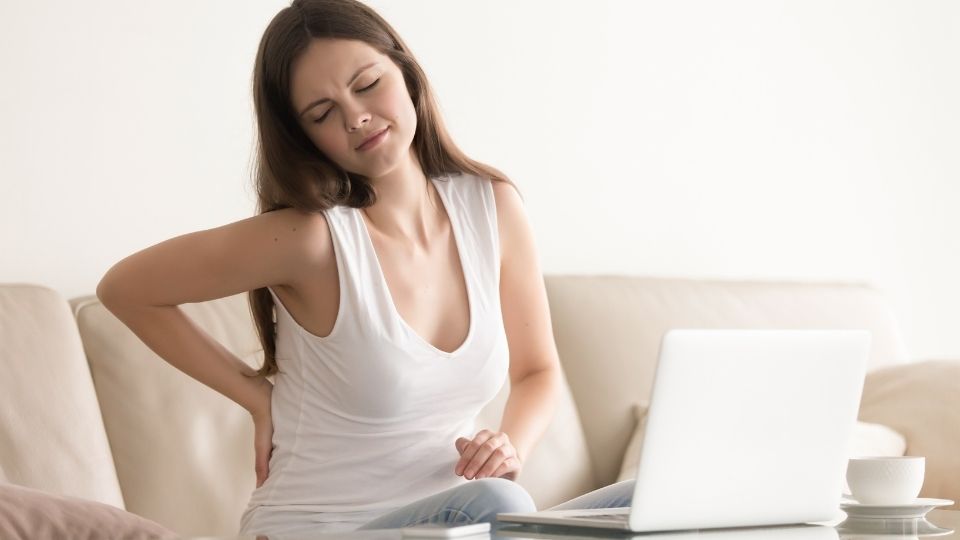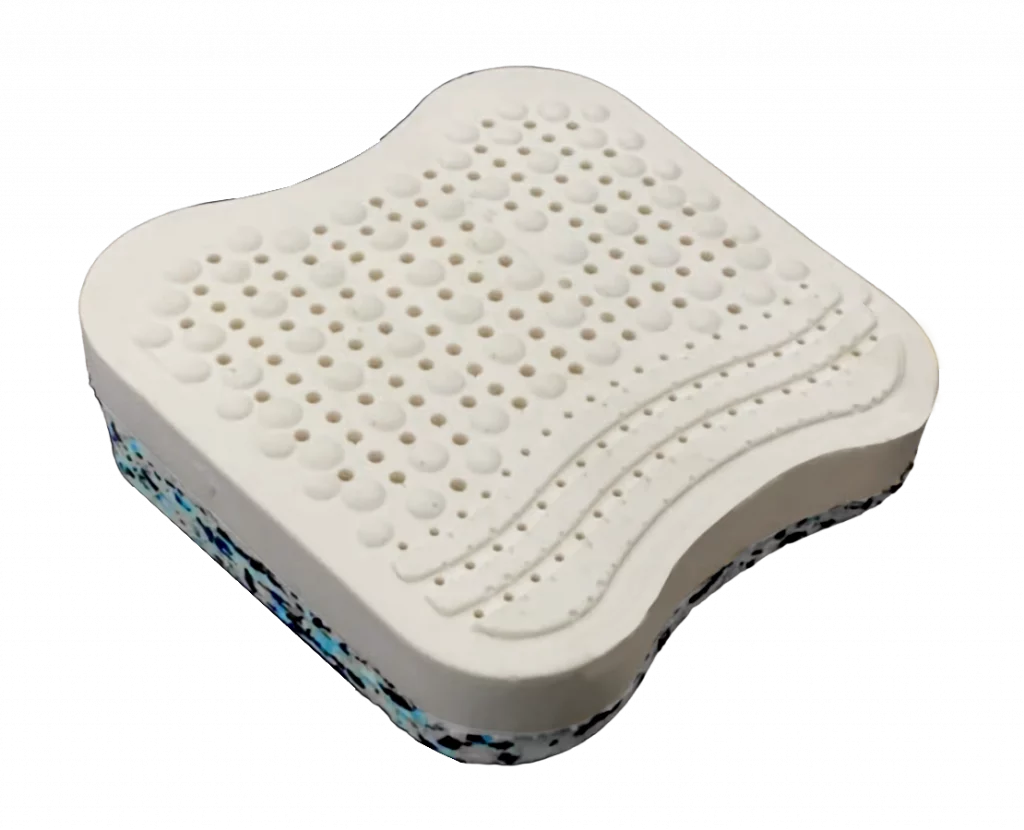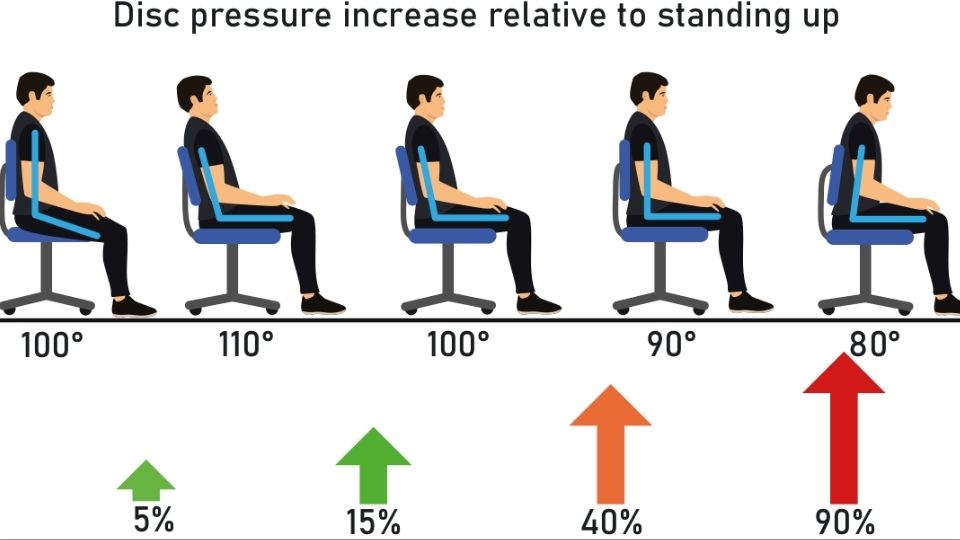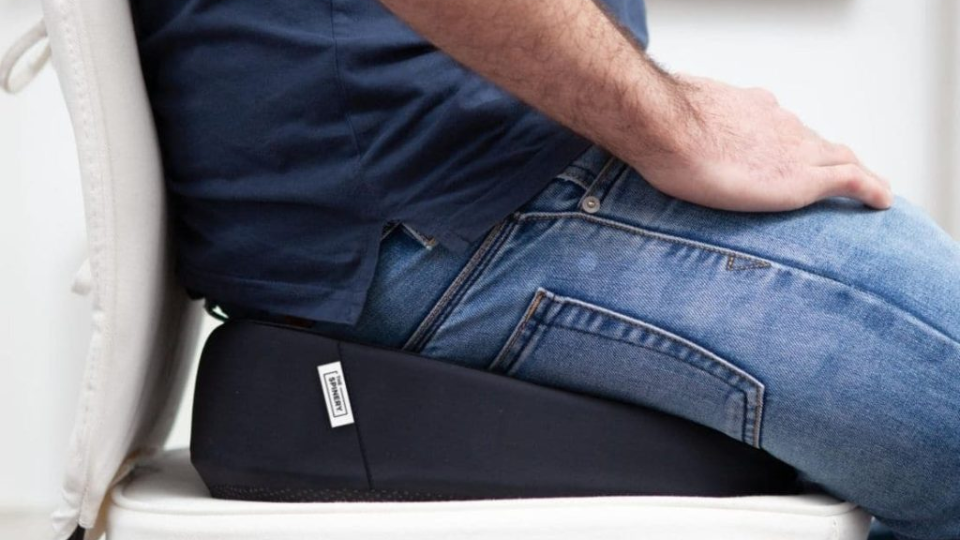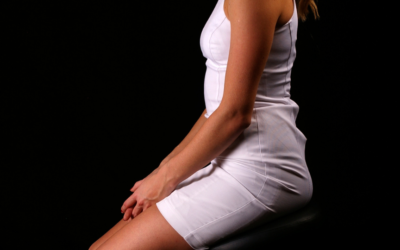If you have been diagnosed with spondylolisthesis, your doctor has probably told you that it is vital to maintain good posture.* But what does that mean for someone who suffers from this condition? Sitting in the right way can help relieve pain and improve mobility. Here are my best tips on the best way to sit with spondylolisthesis.
As a general rule, the best way to sit if you are suffering from spondylolisthesis is by getting your seat height as high with both feet flat on the floor, using a lumbar cushion, and having an 8-10 degree forward tilt.
*This is my opinion as a doctor of chiropractic and seat designer.
If you’re wondering what the best way to sit if you are suffering from spondylolisthesis is, I believe I can help. For over 30 years, I’ve been practicing chiropractic and physiotherapy, and during that time, I’ve also trained as an ergonomist. In addition, I ran a successful Kickstarter campaign to fund the development of my latest project, a set of ergonomic seat cushions. With all this experience and expertise, I’m confident I can offer some helpful insight.
All Day Comfort & Support
What is a Spondylolisthesis?
Spondylolisthesis is a condition in which one of the bones in your spine, called a vertebra, slips out of place. This condition can happen anywhere along the spine, but it is most common in the lower back. The condition can be painful, but some treatments can help.*
In most cases, spondylolisthesis is caused by a degenerative condition, such as arthritis. However, it can also be caused by an injury or congenital disability. If you have spondylolisthesis, you may experience pain and stiffness in your back. You may also have difficulty moving your back or standing up straight.
Black Friday: 35% Off Today
Typical Delivery 1-3 Days
How Do You Sit With Lumbar Spondylosis?
Poor posture is a common cause of back and leg pain, particularly for those who suffer from spondylolisthesis*. The condition occurs when the vertebrae in the spine slip out of place, putting pressure on the nerves and causing inflammation.
While various solutions are available, one of the simplest and most effective is to sit up straight. You can accomplish this by using an orthopedic seat cushion. The cushion helps keep the spine aligned and may reduce pressure and discomfort while sitting.
The wedge-shaped cushion design offers many benefits that make it ideal for sitting comfortably. The extra surface area provided by the wedge gives you more room to shift around and find a comfortable position, and the higher hip joint angle created by the wedge helps to improve your posture.
Additionally, the forward tilt of the wedge helps to distribute your weight more evenly, potentially reducing pressure on your spine. Whether you’re looking for a comfortable seating solution or want to improve your posture, a wedge-shaped cushion can be a helpful option.
What Should You Not Do With Spondylolisthesis? | What Can Make Spondylolisthesis Worse?
If left untreated, spondylolisthesis may worsen over time. This ailment can be due to continued participation in activities that stress the spine, such as high-impact sports or lifting heavy objects. Poor posture, I believe, can be a significant contributing factor to the condition, as can a motor vehicle accident or any other trauma to the spine.
All Day Comfort & Support
Does Sitting Cause Spondylolisthesis Pain?
While sitting may not directly cause spondylolisthesis pain, improper sitting posture can aggravate existing spinal conditions and may lead to new ones.
The spine is designed to bear weight in an upright position, so when we sit, all that weight is transferred to a relatively small surface area. This weight can strain the spine, especially if we sit for long periods.
Additionally, slouching or slumping in our seats can cause the spine to curve unnaturally, putting even more pressure on the vertebrae. Over time, this can lead to degenerative changes in the spine, such as the development of spondylolisthesis.
So while sitting itself may not be painful, improper sitting posture can contribute to spinal problems like spondylolisthesis.
Black Friday: 35% Off Today
Typical Delivery 1-3 Days
How Do You Stop Spondylolisthesis From Progressing?
Exercise
While there is no cure for spondylolisthesis, there are some things that you can do to stabilize the condition and help relieve symptoms. One such treatment is known as the McKenzie method.
This exercise involves lying on your back with your knees bent and your feet flat on the floor. Next, you will engage your abdominal muscles to pull your belly button toward your spine and flatten your lower back onto the floor. Finally, you will hold this position for 15 seconds before relaxing. Repeating this process several times daily can help stabilize the spine’s bones and reduce pain and stiffness.
Correct Your Mechanics
As anyone with spondylolisthesis can attest, it with a wide variety of side effects. One of the less pleasant side effects can be back pain, particularly when sitting.
A forward tilt when sitting is important for maintaining proper posture. This can be achieved by having your hips higher than your knees and shifting the weight from your spine to your core. While an ergonomic office chair can provide this, other options such as an ergonomic cushion may also be helpful.
Adjusting your posture this way can help take some of the strain off your back muscles and may ease pressure on the sciatic nerve. Additionally, it’s essential to stay active. Regular exercise helps to strengthen the muscles that support the spine and can also help to improve circulation and reduce inflammation.
How Do You Stop Spondylolisthesis Pain?
When it comes to managing spondylolisthesis-related pain, several different treatment options are available. However, one of the most effective is laser therapy. Cold laser therapy is a non-invasive treatment that uses laser energy to reduce pain and promote healing. The laser energy penetrates deep into the tissues, providing relief from pain and inflammation. In addition, laser therapy can help to stimulate the repair and regeneration of damaged tissues. As a result, laser therapy is an excellent option for those suffering from spondylolisthesis-related pain.* *
Medical advice typically involves rest, ice, and over-the-counter pain relievers. If these measures don’t provide relief, your doctor may recommend nonsurgical treatments such as activity modification, bracing, physical therapy, or pain relief medication. In some cases, a corticosteroid injection may be recommended to help reduce inflammation and pain. Surgery may be necessary if nonsurgical treatments don’t relieve your pain or if your spine bone is slipping too much.
When managing spondylolisthesis-related pain, one of the best pieces of advice is to make sure you’re sitting correctly. This means that you shouldn’t put all your weight on your spine but rather distribute it evenly into your muscles. By doing this, you can avoid putting pressure on your spine and making the pain worse. Instead, you’ll be able to sit comfortably and reduce the amount of pain you’re experiencing. Additionally, it’s important to avoid sitting for long periods in one position, as this can also aggravate the pain. If you take these precautions, you may be able to minimize the amount of pain you’re feeling and make it more manageable.*
Is Spondylolisthesis a Permanent Disability?
Not always. Some people live everyday life with spondylolisthesis. Advanced (rare) cases may require surgical intervention. With early diagnosis and treatment, most patients can find relief from their symptoms and avoid further complications. But even in these cases, prompt treatment can often help avoid long-term problems. So if you think you may have spondylolisthesis, don’t wait to get help. The sooner you seek intervention, the better your chances are of living a pain-free life.
Why Is Spondylolisthesis So Painful?
The most common symptom of spondylolisthesis is lower back pain, although some people may also experience leg pain. If the condition is severe, it can cause nerve damage and paralysis.
Can a Chiropractor Fix Spondylolisthesis?
No. Surgery is the only way to completely correct the problem, but chiropractic care and getting your posture right can help to manage it, especially if the spondylolisthesis is mild.
Chiropractic care helps to align the spine and relieve pressure on the vertebrae, while Makenzie’s exercises (mentioned above) help strengthen the spine’s muscles. Together, these treatments can relieve those with mild spondylolisthesis and may help them avoid surgery.
Will an MRI Show Spondylolisthesis?
Absolutely. Spondylolisthesis is often diagnosed using MRI, as the vertebrae can be visualized on the scan. However, in some cases, CT or plain radiographs may also be used to confirm the diagnosis. Spondylolysis, a common cause of spondylolisthesis, may be difficult to appreciate on MRI, so CT or plain radiographs may be ordered to get a better view.
Conclusion
If you are suffering from spondylolisthesis, I hope the information in this blog post will help you to find relief.
Adjust your seat height, use a lumbar cushion, and tilt your chair forward 8-10 degrees for the best results. And if you have any questions or concerns, please do not hesitate to contact me or another healthcare professional.
Sources:
- Meyerding, H.W., 1931. Spondylolisthesis. JBJS, 13(1), pp.39-48.
- Lombardi, J.S., Wiltse, L.L., Reynolds, J., Widell, E.H. and Spencer 3rd, C., 1985. Treatment of degenerative spondylolisthesis. Spine, 10(9), pp.821-827.
- Wiltse, L.L., Newman, P.H. and Macnab, I.A.N., 1976. Classification of spondyloisis and spondylolisthesis. Clinical Orthopaedics and Related Research®, 117, pp.23-29.
- Sengupta, D.K. and Herkowitz, H.N., 2005. Degenerative spondylolisthesis: review of current trends and controversies. Spine, 30(6S), pp.S71-S81.
- Wiltse, L.L. and Winter, R.B., 1983. Terminology and measurement of spondylolisthesis. JBJS, 65(6), pp.768-772.
- Lowe, R.W., Hayes, T.D., Kaye, J., Bagg, R.J. and Luekens, C.A., 1976. Standing roentgenograms in spondylolisthesis. Clinical Orthopaedics and Related Research, (117), pp.80-84.
- Matsunaga, S., Ijiri, K. and Hayashi, K., 2000. Nonsurgically managed patients with degenerative spondylolisthesis: a 10-to 18-year follow-up study. Journal of Neurosurgery: Spine, 93(2), pp.194-198.
- Hartvigsen, J., Leboeuf-Yde, C., Lings, S. and Corder, E.H., 2000. Is sitting-while-at-work associated with low back pain? A systematic, critical literature review. Scandinavian journal of public health, 28(3), pp.230-239.
- Zhou, Q.S., Sun, X., Chen, X., Xu, L., Qian, B.P., Zhu, Z. and Qiu, Y., 2021. Utility of natural sitting lateral radiograph in the diagnosis of segmental instability for patients with degenerative lumbar spondylolisthesis. Clinical Orthopaedics and Related Research®, 479(4), pp.817-825.
- DeVine, J.G., Schenk-Kisser, J.M. and Skelly, A.C., 2012. Risk factors for degenerative spondylolisthesis: a systematic review. Evidence-based spine-care journal, 3(02), pp.25-34.
- Ahn, Y., Keum, H.J., Shin, S.H. and Choi, J.J., 2020. Laser-assisted endoscopic lumbar foraminotomy for failed back surgery syndrome in elderly patients. Lasers in Medical Science, 35(1), pp.121-129.
- Mark Studin, D.C., Chiropractic Outcome Studies on Treatment of Fragmented/Sequestered and Extruded Herniated Discs and Radicular Pain.





